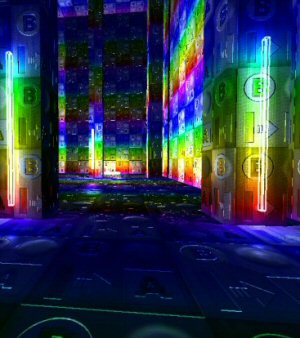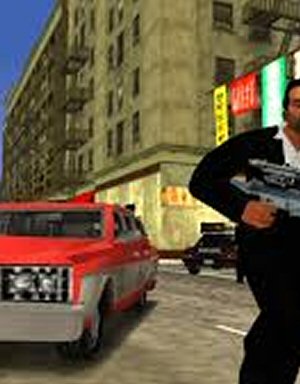After learning the basics of RollerCoaster Tycoon, the game now runs you through scenario after scenario increasing the perceived difficulty by tightening and eventually combining restrictions. These restrictions all follow simple ideas:
- Decreasing the available space
- Increasing the difficulty of using the underlying terrain
- Starting with a functional park that is handicapped with pre-existing limitations or problems
- Unusual or arbitrary restrictions, including restricting the amount of money available over the course of the scenario
These particular difficulties carry the game through all of the original scenarios. Everything but monetary restrictions are stated or obvious, making that last detail a bit of a surprise when you encounter it. So let’s take a look at the various routes, which start immediately after the 5th scenario, Evergreen Gardens.

The first family, Space Restrictions, are usually *very* obvious. The 6th Scenario, Bumbly Beach, is described simply: “Develop Bumbly Beach’s small amusement park into a thriving theme park.” The win conditions are to have 750 guests at the end of two years while maintaining a park rating of 600. As usual, this is actually very simple once you have your park-legs under you. The park starts with a popular, well-running rollercoaster to bring guests in (that’s literally the name of the game), but two Gentle Rides at opposite ends of the park. While the distance creates room for guests to spread out and not feel “overcrowded,” they also don’t like looking for a fun ride and not seeing one. Thankfully you have a lot of Gentle Rides already available to start laying out along the main pathway. The second challenge is that you have only one Thrill Ride to satisfy guests that need more adrenaline. So that is *clearly* a research priority. Also, once again, you have only three food stalls available. If you want guests to be thrilled with your food, and as you know *I* certainly do, you will need a fourth *type* of food stall along with seven total installed and running to impress RollerCoaster Tycoon Monthly enough to get an award. But honestly, you do start with the Information Kiosk available, the biggest moneymaker and driver of foot traffic to rides not immediately visible, so considering this is only a two-year scenario…maybe the food isn’t so important. You can see from the picture above I didn’t get much installed in the first two years. It will take a full season of building just to get your guest count high enough to start funding a second surge of building, and you only have another season to do *that*. A final note: you can actually buy building rights across the main road and on the beach; this will allow you to base any kind of tracked ride in your park grounds then build them out over this new area. I have never done this, but if you wanted to continue this scenario past the win conditions, it would be necessary to maximize the park.

Three scenarios later we reach #9, Dinky Park. Dinky Park is almost un-usably tiny. You can see I only built one rollercoaster, and that one is a joke. You can buy construction rights over the highway, and land across the highway to the east (the water), but this is expensive. Even so, I did buy enough constructions rights to put the rollercoaster in, because even a crappy rollercoaster is better than none. You have a good selection of Gentle and Thrill rides, several available and several available to research. The win condition for Dinky Park is to double your park value to $10,000. “Park Value” is a moving target that is hard to track, because the numbers that create it aren’t actually presented in your financial records. Park Value is determined by how much income the rides in your park *at the moment you observe the number* would generate under ideal conditions. However, this also takes into account a kind of “popularity” depreciation. Older rides are less popular than newer rides, even if guests think they are a great value because you made them free. Beyond that, as I said, the number is derived from how much the ride *could* make based on assumptions…*not* based on how much you might be charging for the ride. What, you think you can just set the ride to $50 per trip and beat the scenario? RCT doesn’t even *think* about that. It’s all based on an artificial assumption so that every ride is normalized and judged the same. A lot of this is summed up in how much money you would make if you sold a ride…so that’s one way to test how much value any given ride is worth. There are numerous reported ways to *cheat* your way around Park Value requirements, but as I mentioned previously, that’s not the direction I approach the game from. Some people say the best solution to Dinky Park is to acquire construction rights and more land in order to build a “big” coaster or two; big coasters bring a LOT of Park Value. I’ve never tried that approach in *this* scenario, but it has certainly worked in others. In fact, some of the most advanced coaster designs don’t even need to be “big” to bring a lot of value. Standing coasters can be quite small and worth way more money than it costs to build them once they get going. But my preferred solution, as you can see, is density. You are going to have to learn to managed stacked paths eventually, so you might as well learn in Dinky Park. The back-half of the park slopes downward constantly, so you’re going to be building a lot of elevated rides and pathways anyway unless you want to spend more money than *new* land costs raising your existing land to a flat plateau, or even a number of usable steps. Sparingly modifying terrain to build your flat rides along a plain will create pockets to tuck more rides in as you work your way to the back of the park. It’s not actually very clear in the picture I posted, as the screenshot is from the front of the park.
While the slope of the land is *technically* also an example of introducing challenging terrain, it is clear from the Park Value requirement (and Park Value being separate from cash reserves) that the space is the challenge here. You won’t face another “Space Restriction” scenario until the 17th, Big Pier.

Big Pier doesn’t seem to be a Space Restriction scenario at first. This is one of a handful of scenarios that might set you off on the wrong path based on assumptions you make. The instructions are simple: make the pier into an amusement park. 600 guests by the end of year 2; maintain a park rating of 600. Believe it or not, it truly is as simple as it sounds, and once you realize the one simple trick, which will become obvious once you try to place a flat ride, shop, or stall, you’ll see how easy it is: the scenario treats the water as land equal to the height of the existing paths for everything but tracked rides. All tracked rides start on the surface of the water as they normally do (with automatic supports placed to the land under the water.) This might not be apparent at first, as your instinct will be to place a large rollercoaster or water ride to the side of the pier, and that’s when you will realize that actually, this is Space Restriction scenario…in fact, it’s easier to beat than Dinky Park. Because you can only build a half dozen squares outside of the pier footprint. Oh, there are coasters that will fit in that space once you research them, but you start out with the Steel Mini- and Wooden Crazy Rodent-types, both of which have built-in tiny designs that fit inside the defined square areas. And since the win conditions are actually quite low, you don’t need much more than this. Big Pier can actually be quite fun from this point. The straight lines create easy-to-work-in spaces that can be packed full without stacking, meaning path-management is straightforward. The small size means you don’t need too many handy-persons or security guards…there just isn’t that much path. You just have to make sure your cleaners aren’t cutting each other off from queue and exit routes. You even start with four different food stalls, meaning you can get awards for Best Food, Best Bathrooms, Safest, and Tidiest in just the two years required to win. I don’t think it’s just me that likes this scenario, either. A later expansion added a “new” version of this scenario where you can build on the land the pier is connected to. Actually a new problem pops up that will be revisited later, and be much worse: it is very difficult to lay out routes for employees, as the “route” marker sticks to the base land, not the path. Underwater, this has a tendency to “offset” from what you can see. This is obviously true above ground as well when you’re trying to mark elevated paths, but underwater base land done like it is in the scenario gives you no frame of reference to line the marks up…it relies on instinct or trial-and-error.

The second family of restrictions, “Difficult Terrain”, takes us back to the 7th scenario, Trinity Islands. I assume they went with “Trinity” instead of “Quaternary” purely because it sounds much better, as the second-half of the first island is only *technically* connected, and really should be treated as a separate space as well. While this is also a “Space Restriction” scenario, the bigger challenge is how the space you’re given is arranged. Getting your park started in the very tight confines of the first island is the hardest thing to accomplish. There is almost no water area available here, on a water-themed map. You will need to cut-off the abundance of paths that run all the way through the park from the start in order to confine guests to where the rides are for the first year. Once you have a few guest-driving rides on the second island/second-half-of-the-first island, you should be able to expand to the *actual* second island rapidly and get some coasters and water features installed over the available lagoon. This is another fun scenario.

The next scenario with a terrain-centric challenge is the 12th, Karts and Coasters. This park starts you with two huge custom Wooden Rollercoasters and two huge custom Go-Kart Tracks. They are well-designed and draw guests. They also take up a lot of space and already have a *lot* of path that needs to be maintained, but as the park is a going, successful venture; adding staff to patrol the grounds and keep your stuff, er, guests, safe isn’t very problematic. Oh, also either shorten the queues for the Go-Kart rides (they are very long and Go-Kart rides are usually *very* slow) or get entertainers in there ASAP. Or even both. You have to have 1000 guests at the end of year 3, and a solid base to build on. But you *will* need more rides, and paths and queues to those rides. And THAT’S where this park gets you. Take a look at the pic above. See the trees? I didn’t add those. Just about every square inch of this park when you start it is covered in trees and bushes. You will have to delete dozens, if not hundreds, of trees to build your rides, and modify terrain, and add paths. I am *serious*, it is frustrating to the point of anger. *Every*single*time* I tried to do ANYTHING I get the notification “You can’t do that. There is a tree in the way.” and I started getting *really* sympathetic for the Once-ler. I can NOT in any honesty say this is a fun scenario purely because of *all*the*damned*trees*.

Only two scenarios later we get another “Difficult Terrain” scenario, this one again paired with “Restricted Space.” In some ways this is a different version of Dinky Park, where you will likely rely on stacked, multilevel building to get you through much of the scenario. Yet, the space you have available is certainly adequate, you just have to build around the fact that you’re transforming a small, steep valley into an amusement park. This can actually be a fun scenario, even as you frequently find a way to install a bigger ride such as a coaster or water slide only to find there is no *good* way to line the queues and paths up. So, you just delete it and try re-positioning the ride. Sure looks pretty when you get it right, though; I think this is one of my favorite “looking” parks so far. But I’m sure, if you stare it it long enough, you will start seeing the layers of rides and paths disappearing under and behind each other.

The 18th scenario, Lightning Peaks, is the purest terrain challenge (there is actually one more that can fit this category, but I’m including it in the “special” scenarios, because the restriction is unusual and arbitrary.) The entrance is at the base of a mountain. A long, narrow path, almost entirely unsuitable for building rides ascends this mountain, as well as a chairlift. At the top of this first mountain paths continue to three other mountain peaks. There is also another chairlift to a second mountain peak. There no flat terrain. But honestly? The biggest challenge is to get everything beyond the second chairlift cut off from the paths and restrict guests to just the two peaks thus made available. You will likely have to move some guests. *And get two information kiosks installed immediately.* This place isn’t called “Lightning Peaks” for nothing…it rains constantly. You want those $20 umbrellas available ASAP. You will have to research it, and while you’re there make sure you get your four kinds of food stalls as well. Then focus on getting as many “covered” rides placed as possible. Guests will use rides in covered cars or with roofs (Merry-go-Round, Haunted House, mainly Gentle Rides) while it’s raining. Also, even though I haven’t really talked about it much, make sure your park has plenty of park benches on level path and clearly-available trash cans. The trash cans help keep litter down (not vomit, though) and guests like to sit while it’s raining, after intense rides, and while they’re eating. Not a hard scenario, although the restricted path up the mountain from the beginning seems arbitrary…or it did until I played the last few scenarios and learned what “arbitrary” meant.

Katie’s World is the first scenario since Diamond Heights where you are handed a fully functional amusement park and asked to double the value. Obviously the park as it exists can’t do that, so you’ll have to build a lot of rides. To build a lot of rides requires a lot of money, and that means you’ll have to leverage what exists to fund what will come, to get guests in the park. This is, in many ways, the “purest” form of the game. Katie’s World does start with three built in coasters, two of which are red flags. The huge wooden rollercoaster at the back of the park can be reduced to only a moderate chance of crashing in the usual way: assign an exclusive mechanic and reduce inspection times to ten minutes. The other problem coaster routes underground (it’s called “Runaway Plumber”) and should probably just be closed and destroyed. Use the money to start funding your theme park expansion. Before long we’ll have to compromise on our “all free rides/high park entrance fee” strategy, but not here. The “run a theme park the best you can” scenarios here in the middle game will frequently see you charging $75-$100 entrance fee before you win the scenario.

Aqua Park starts as a successful Water Rides park, but only requires you increase the guest count after a few years. The built-in rides don’t have any particular problems, but the park layout *is* a challenge. From the beginning you will be notified of the occasional guest being unable to find the exit. This occurs because the built-in River Rapids ride is located opposite the entrance across the lake, *and* to the left of the entrance (from that picture’s point-of-view). Also note the paths that edge the left side of the lake don’t exist at the beginning of the scenario; I added those. Likewise the chairlift that crosses the lake. Because people that exit the ride are closer to the entrance that the path back around the *right* side of the lake will take them (remember talking about that?) they keep wandering in this area unable to return to the entrance. The solution is the path around the left side of the lake, which hopefully you will realize sooner rather than later. Especially now that I’ve given you the solution. The chairlift *helps,* but doesn’t make the problem go away. And that’s the only real challenge here.

Millennium Mines comes right after Aqua Park, and inverts almost everything. You start with ONE ride, and it’s very slow with a long queue. Yet your goals are almost identical to the previous scenario. The terrain is the biggest challenge here, and in fact it precedes two scenarios I classify as “Difficult Terrain.” Millennium Mines, however, is so open you can work the terrain easily. You may have to build custom versions of some rides until you can afford to wholesale-flatten large areas, but you start out with enough easily-worked, nearly-flat land that you can get your park established quickly. As in Lightning Peaks, you get a lot of rain around here, so prioritize getting an Information Kiosk up-and-running to sell umbrellas. And generally, follow the same wet-weather advice I gave there.

Mel’s World, the 13th scenario, is just Katie’s World, and then some. You have good rides, plenty of space, no difficulties. Just build a big, beautiful park as fast as you can. As you can see, this one went smoothly enough that I was able to get heavily in theming. This is a fun scenario that is predicated simply on running the park well and building constantly.

The last scenario for today is the 19th, Ivory Towers. The description for Ivory Towers is “A well established park, which has a few problems.“
Yeah.
The rides are good, although technically one of the coasters is a bit too extreme. I just ignored that and made sure I had double-bathrooms and lots of park benches available at the exit. You *can* get into trouble with pathing here. You can see from the pic the park naturally divides into separate fill-able areas, and you don’t want to create a situation where a guest has to go “back” to go “forward.” But you will see the problem immediately on starting the scenario: almost every path square has vomit and litter. Almost every park bench and trash can and lamp post is broken. You have NO STAFF, and apparently haven’t for a long time. And you can’t really get rid of much path, even at the beginning. You have a well-functioning park; you can’t really delete anything. So: you have to balance hiring staff, replacing amenities, and growing the park a bit while managing your money, and you have to do it as soon as possible. There really isn’t a “trick” to it…you just have to do it. The good news is, if you’ve been playing using the tips I’ve given so far, this won’t actually be hard…it’ll just be overwhelming at first because you can’t do everything all at once. You have to be as smart as you can about it. You can see in the pic I don’t actually have a ton of rides here, and that’s because most of the effort was spent in cleaning the existing park up, which maximizes its value. You can get your entrance fee up quite high just doing that. In fact, the first year you can start with a $10 or $15 dollar entrance fee and up it $5 every single month. That gets you up to $50/$55 dollars entrance fee in once season, and it’ll keep going up the second season. It’s a good park. This can be a fun scenario that requires a lot of smart, hard work right at the beginning; followed by years of being picky to add the right rides in the right places. After all, this is Ivory Towers. (Also note this park is bigger than it looks. I have FOUR food courts installed, and every stall made money.
That’s it for this week folks. See you next time!
Trusting the System

How do you know the rules of the game are what the game claims? More importantly, how do the DEVELOPERS know?
Final Fantasy X

A game about the ghost of an underwater football player who travels through time to save the world from a tick that controls kaiju satan. Really.
The Strange Evolution of OpenGL

Sometimes software is engineered. Sometimes it grows organically. And sometimes it's thrown together seemingly at random over two decades.
Grand Theft Railroad

Grand Theft Auto is a lousy, cheating jerk of a game.
The Mistakes DOOM Didn't Make

How did this game avoid all the usual stupidity that ruins remakes of classic titles?
 T w e n t y S i d e d
T w e n t y S i d e d

This seems like an interesting progression of challenges. My strongest memory of theme parks is that I regretted not going on a certain ride one time when I was very young, and then it closed down and a similar ride never came back to any theme park I had access to.
The Star Wars virtual shuttle ride at Eurodisney was pretty neat though.
I have a celebrity version of that memory. Two or more decades ago, a B-movie star was going to have a one-night public appearance in a nearby city. I was a big fan, and my spouse and I made the trip. At the last minute I chickened out (this was a tiny venue and I would almost certainly come face-to-face with the person) and turned around and drove home.
They died about a year and half later.
Back on theme parks, I have heard a lot the last few years that Eurodisney may actually be the best current Disney park. I doubt I will get the chance to find out for myself, and honestly it’s been years and years since I visited one here in the U.S., so I wouldn’t be able to make a direct comparison anyway.
One of the great things about RCT1 is that it has a pretty good difficulty curve. As one progresses there are definitely some scenarios that are easier than others but the curve is much smoother than in RCT2. I prefer to charge per ride than to charge per entrance fee since that means the popular rides (mostly rollercoasters and some thrill rides) make more money and can help subsidize the lower earning rides and stalls, which are also important to reach the guest goal, though it also means once the guest spends all their money they don’t tend to stick around very long and some guests will enter the park and leave after about 6-7 minutes without ever having gone on a ride and thus not generate any revenue for the park. From Youtube videos it looks like I undercharge in many situations but I don’t like dealing with the micromanagment required to maximize park income. Even then in longer scenarios I may still have to drop the price to keep guests willing to pay and go on a particular ride.